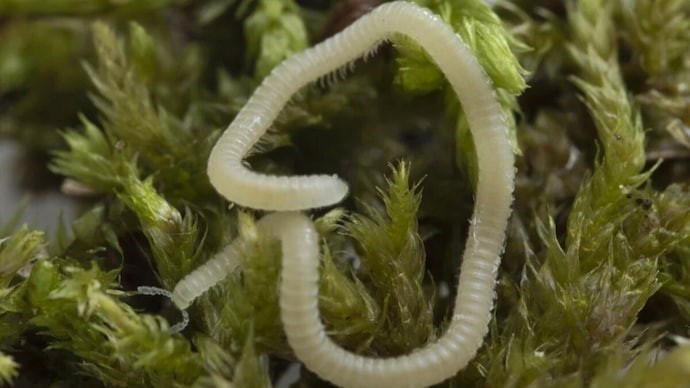Description

Disclaimer: Copyright infringement not intended.
Context
- A new species of millipede has been discovered crawling underneath the city of Los Angeles in the United States.
Details
Glossy and Blind Arthropod
- A new species of millipede has been found underneath Los Angeles, United States.
- It is a stunning creature, as thin as pencil lead and about the length of a paperclip.
- The millipede is translucent and sinuous, resembling a jellyfish tentacle.
- Its blind nature adds to its mystery, and it relies on hornlike antennas to navigate its subterranean world.
Microscopic Marvel
- Under a microscope, the millipede's helmet-like head and 486 legs make it appear like a creature from a Hollywood monster film.
Named After Los Angeles
- The species is scientifically named Illacme socal, after the city of Los Angeles where it was found.
Conservation Challenges
- Earth may be home to around 10 million animal species, but only one million have been identified so far.
- Los Angeles alone is estimated to house 20,000 species of insects, but threats like climate change and invasive species endanger native biodiversity.
Protecting Precious Resources
- Conservation efforts, such as preserving local parks and wild patches of land, are crucial in safeguarding Earth's biodiversity.
- Understanding and utilizing these resources responsibly are vital solutions for the challenges that lie ahead.
.jpg)
Millipedes
- Millipedes are fascinating arthropods belonging to the class Diplopoda, which is part of the Myriapoda subphylum.
- Despite their name, millipedes do not have a thousand legs, but they are known for having a large number of legs compared to their close relatives, the centipedes.
- These creatures have been around for millions of years, with some fossil evidence dating back to over 420 million years ago during the Silurian period.
- Millipedes play important roles in ecosystems, and they have unique adaptations that make them intriguing creatures to study.
Physical Characteristics
- Millipedes have elongated bodies with numerous segments, each bearing two pairs of legs, except for the first three segments that have a single pair of legs.
- The number of segments and legs can vary among different species, but in general, they have between 30 to 400 legs.
- These legs give them a distinctive, worm-like appearance.
- Their bodies are cylindrical, and they can range in size from a few millimeters to several centimeters, depending on the species. Millipedes have a hard exoskeleton that protects their bodies.
Habitat and Distribution
- Millipedes are found in a wide range of habitats around the world.
- They prefer moist environments such as forests, woodlands, grasslands, and gardens.
- They are typically nocturnal, coming out at night to feed on decaying plant matter and detritus, which is their primary food source. Some species of millipedes can be found in caves and even aquatic environments.
- They are found on every continent except Antarctica.
Feeding and Diet
- Millipedes are detritivores, which means they primarily feed on decaying organic matter, including dead leaves, plant debris, and other organic materials.
- They play a crucial role in the decomposition process, breaking down organic matter and returning nutrients to the soil.
- Millipedes have specialized mouthparts called mandibles that help them chew and consume their food.
Defense Mechanisms
- One of the most intriguing aspects of millipedes is their defense mechanisms.
- When threatened, many millipedes have the ability to release a defensive chemical substance from special glands on their bodies.
- This liquid contains compounds such as hydrogen cyanide, which is highly toxic to predators.
- The defensive fluid can irritate the skin and mucous membranes of potential predators, acting as a deterrent against being eaten. Some species can also roll into a tight spiral to protect their softer underside.
Reproduction and Life Cycle
- Millipedes reproduce sexually, with males and females coming together for mating.
- After mating, females lay eggs in the soil, and the eggs hatch into young nymphs.
- The young millipedes go through several stages of molting as they grow, shedding their exoskeleton to accommodate their increasing size.
- The molting process is essential for their growth and development.
Ecological Importance
- Millipedes play a vital role in ecosystems by aiding in the decomposition of organic matter.
- Their feeding habits help break down dead plant material, contributing to nutrient cycling and soil health.
- As detritivores, they help maintain the balance of the ecosystem by removing decaying matter and returning nutrients to the soil, which benefits plants and other organisms.
Conclusion
In conclusion, millipedes are intriguing arthropods with unique adaptations and important ecological roles. Their ability to break down organic matter and release defensive chemicals showcases their fascinating characteristics. By understanding and appreciating these creatures, we can gain valuable insights into the intricate workings of nature and the balance of ecosystems. The discovery of the Los Angeles Thread Millipede, with its unique features and enigmatic nature, reminds us of the hidden wonders beneath our feet and the importance of preserving and exploring Earth's rich biodiversity for a sustainable future.
|
PRACTICE QUESTION
Q. Which of the following statements about millipedes is/are correct?
1. Millipedes are insects belonging to the class Diplopoda.
2. Millipedes have one pair of legs per body segment.
3. Millipedes are venomous and can deliver a harmful sting.
Select the correct option:
a. Only statement 1 is correct.
b. Statements 1 and 2 are correct.
c. Statements 2 and 3 are correct.
d. All of the above statements are correct.
Answer: a
|

https://www.indiatoday.in/science/story/blind-gloosy-with-486-legs-new-millipede-species-discovered-2412462-2023-07-27












